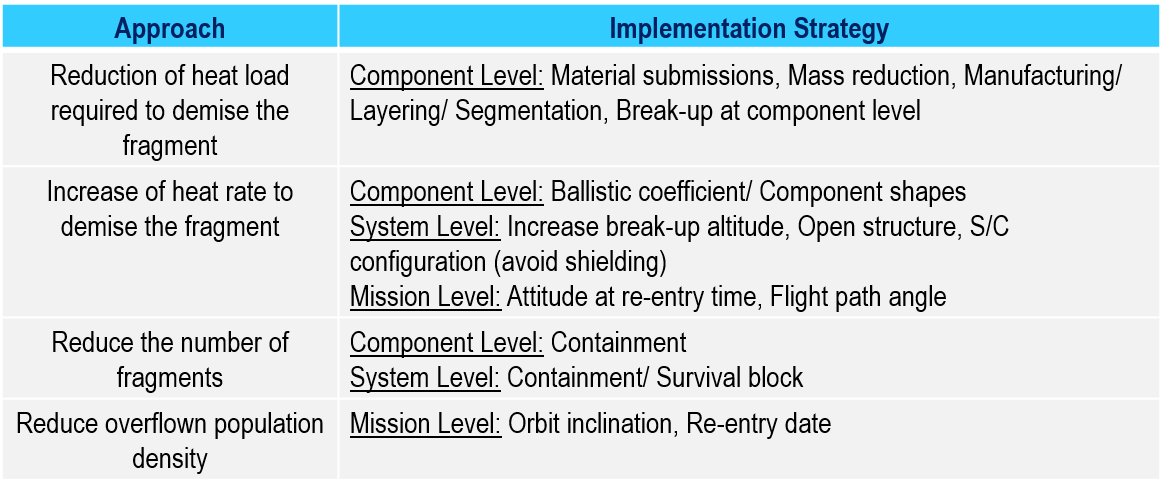Design For Demise
Design for demise concepts are solutions at different design levels of spacecraft systems and hardware aimed at ensuring compliance with the casualty risk requirement during an uncontrolled re-entry. But it is very relevant to note that, demisability of a spacecraft or an object competes against the survivability during the mission lifetime making design for demise a multi-criteria and multidisciplinary problem. However, a lot of important research has taken place during the past decade and several important design for demise methodologies have been highlighted. D4D approach [1][2] generally progresses in the following fashion,
- Identify critical components in a satellite with respect to on-ground casualty risk
- Identifying design concepts to improve demisability of spacecraft at component, system and subsystem levels
- Applying the identified design for demise techniques to a case study and estimate the risk reduction
- To derive any general guidelines for use in future missions
Large spacecraft generally cannot reduce the risk adequately for uncontrolled entries, and must therefore be designed to have a controlled entry landing in the ocean. Satisfying the casualty risk requirements of ESA may increase the overall cost of such missions considerably high. Typical components of satellites in reference mission class (LEO spacecraft in the 800kg to 4 tonne class) that contributed most to the casualty risk metric [2] are,
- Propellent tanks (titanium alloys)
- Reaction wheels (specifically steel flywheels)(RWs)
- Optical benches (eg., Laser Communication Terminal)(LCT)
- Balance masses
- Magnetic torquers (specifically iron cores)(MTQs)
The main factors that make an object critical are ([1]-[5]),
- High melting point and heat capacity :: materials made of titanium, SiC and steel
- Size and mass :: large objects have more material to ablate
- Location of components :: are they protected within the structure?
- Altitude of exposure :: internal parts are exposed late to the heat flux
- Degree of fragmentation :: more surviving fragments imply more casualty area!
Parametric low-fidelity analysis using object-oriented re-entry analysis tools is carried out for the critical components (individually) to identify major reasons of survivability. This information is used to improve upon the design for demise. Now that we have the reasons for survivability, the next objective is to identify the design for demise techniques that can be classified by assessing benefits to develop and use the most promising techniques. These techniques can then be implemented to the spacecraft and the risk reduction can be validated using detailed spacecraft oriented re-entry analysis tools. Different design for demise approaches can be seen in the Table.1,

Case study
Need to be completed!
References
[1] Grassi, Lilith, et al. “Design for demise techniques for medium/Large LEO satellites reentry.” 7th European Conference on Space Debris. Available: https://conference.sdo.esoc.esa.int/proceedings/sdc. Vol. 7. 2017.
[2] Riley, David, et al. “Design for Demise: Systems-level techniques to reduce re-entry casualty risk.” 7th European Conference on Space Debris, ESOC, Darmstadt, Germany. 2017.
[3] Kärräng, Patrik, Tobias Lips, and Tiago Soares. “Demisability of critical spacecraft components during atmospheric re-entry.” Journal of Space Safety Engineering 6.3 (2019): 181-187.
[4] Heinrich, Stéphane, Joel Martin, and Julien Pouzin. “Satellite design for demise thermal characterisation in early re-entry for dismantlement mechanisms.” Acta Astronautica 158 (2019): 161-171.
[5] Beck, James C., et al. “Design-for-Demise Analysis using the SAM Destructive Re-Entry Model.” Stardust Final Conference. Springer, Cham, 2018.